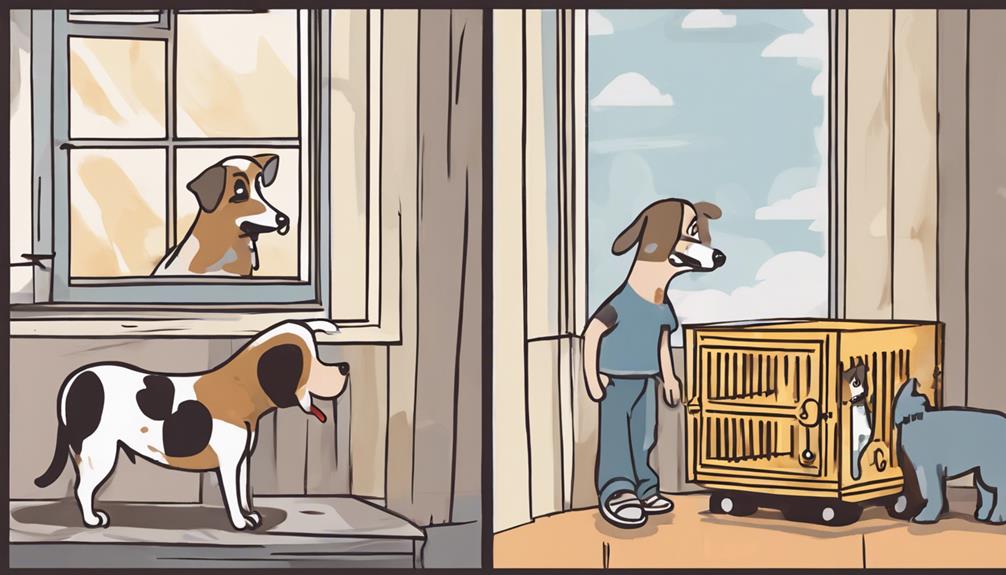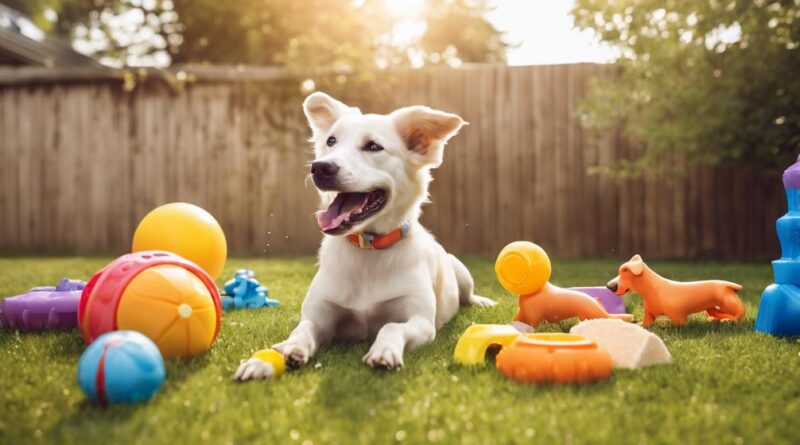Three Essential Tips for Your Dog's Emotional Health
Ensuring your dog's emotional well-being is as crucial as providing food and shelter. But have you ever pondered how to truly understand and address your furry companion's feelings?
By implementing three key strategies, you can significantly enhance your dog's emotional health and overall happiness.
So, let's explore these essential tips together and uncover the potential they hold for strengthening the bond between you and your beloved pet.
Understanding Canine Emotions
To understand canine emotions better, observe their body language and vocalizations. Exploring body language is crucial in decoding what your furry friend is feeling. Dogs communicate through a variety of physical cues, such as tail wagging, ear position, and overall posture. A wagging tail doesn't always mean they're happy; it could signify excitement, nervousness, or even aggression. Pay attention to the speed and height of the wag to get a better grasp of their emotional state.
Recognizing stress signals is equally important. Dogs exhibit signs of stress when they feel threatened, anxious, or overwhelmed. These signs can include lip licking, yawning, panting when not hot, and avoiding eye contact. If you notice your dog displaying these stress signals, it's essential to create a calm environment for them and offer reassurance.
Building Trust With Your Dog
Understanding your dog's emotions is the foundation for building trust with them. Building confidence and improving communication skills are key elements in fostering a strong bond with your furry friend.
To enhance your relationship with your dog, consider the following tips:
- Consistent Training: Establishing a consistent training routine can help your dog feel more secure and confident. Regular training sessions can also improve communication between you and your pet.
- Positive Reinforcement: Rewarding good behavior with treats, praise, or playtime can boost your dog's confidence and strengthen the trust they've in you.
- Quality Time: Spending quality time with your dog through walks, play, or simply relaxing together can help deepen your connection and build trust.
- Body Language Awareness: Pay attention to your dog's body language to better understand their emotions and needs. This awareness can improve your communication skills and strengthen the bond between you and your pet.
Creating a Safe Environment
Creating a safe environment for your dog involves implementing measures to ensure their physical and emotional well-being. One way to achieve this is by creating boundaries within your home. Establishing clear rules and limits can help your dog feel secure and understand what's expected of them. Whether it's designating certain areas as off-limits or training them to wait before entering or exiting the house, boundaries provide a sense of structure that can be comforting for your furry friend.
Promoting relaxation is another key aspect of creating a safe environment for your dog. Make sure they have a cozy and quiet place where they can retreat to when they need some peace and quiet. Consider setting up a comfortable bed or crate in a low-traffic area of your home where your dog can relax and unwind. Creating a calming atmosphere with soft lighting, soothing music, or aromatherapy can also help your dog feel more at ease and reduce stress levels. By implementing these measures, you can help your dog feel safe, secure, and emotionally balanced in their environment.
Engaging in Play and Exercise
Establishing a routine of engaging in play and exercise is crucial for maintaining your dog's emotional well-being and physical health. Keeping your furry friend active and entertained not only helps in preventing boredom but also fosters a strong bond between you and your pet.
Here are four key tips to enhance your dog's emotional health through play and exercise:
- Interactive Toys: Invest in toys that stimulate your dog's mind and encourage physical activity. Toys like puzzle feeders or interactive balls can provide mental enrichment and keep your dog engaged.
- Outdoor Adventures: Take your dog on regular walks, hikes, or trips to the dog park. Outdoor activities not only provide physical exercise but also expose your dog to new sights, smells, and experiences.
- Playtime Variability: Keep play sessions exciting by mixing up activities. Whether it's playing fetch, tug-of-war, or hide-and-seek, varying playtime keeps your dog mentally stimulated.
- Training Games: Incorporate training sessions into playtime. Teaching your dog new tricks or commands can be a fun way to challenge their mind and strengthen the bond between you.
Establishing Routine and Consistency
Consistency in daily activities is key to providing your dog with a sense of security and structure in their routine. By maintaining a consistent schedule for feeding, walks, playtime, and training, you create a stable environment that helps reduce stress and anxiety in your furry friend. Incorporating positive reinforcement techniques, such as rewarding good behavior with treats or praise, can further enhance your dog's understanding of what's expected of them.
Additionally, socialization techniques play a crucial role in establishing routine and consistency. Exposing your dog to different people, animals, and environments from an early age helps them feel more comfortable and confident in various situations. This exposure can prevent fear or aggression towards unfamiliar stimuli, making your dog more adaptable and well-rounded.
Providing Mental Stimulation
To keep your dog mentally engaged and fulfilled, provide various interactive toys and puzzles designed to challenge their cognitive abilities. Enriching activities and cognitive challenges are essential for your furry friend's mental well-being.
Here are four ways you can incorporate mental stimulation into your dog's routine:
- Interactive Toys: Invest in toys that dispense treats when manipulated, encouraging your dog to think and problem-solve.
- Puzzle Feeders: Use puzzle feeders to make mealtime more engaging, stimulating your dog's mind while they eat.
- Hide and Seek: Hide treats around the house or yard for your dog to find, tapping into their natural scavenging instincts.
- Training Sessions: Regular training not only reinforces good behavior but also provides mental exercise and strengthens the bond between you and your dog.
Managing Separation Anxiety

Help alleviate your dog's separation anxiety by gradually acclimating them to your departures through short practice sessions. Start by practicing short absences, gradually increasing the time you're away. This helps your dog learn that you'll always return. Utilize training techniques like giving them a special treat or toy when you leave to create a positive association with your departure.
Behavior modification is key in managing separation anxiety. Make your departures low-key to avoid escalating your dog's anxiety. Keep greetings and goodbyes brief and calm. Additionally, desensitize your dog to departure cues such as picking up keys or putting on shoes by doing these actions without leaving. This can help reduce their stress response to these triggers.
Creating a safe space for your dog with comforting items like blankets or clothing that smells like you can also help. Remember, consistency and patience are crucial in addressing separation anxiety. By implementing these training techniques and behavior modifications, you can help your furry friend feel more secure when you're not around.
Seeking Professional Help if Needed
If your dog's separation anxiety persists despite your efforts, consider consulting a professional for specialized assistance. Sometimes, seeking help from experts can provide valuable insights and strategies to improve your dog's emotional well-being. Here are some steps you can take:
- Therapy Options: Professional dog trainers or animal behaviorists can offer therapy sessions tailored to address your dog's specific emotional needs. These sessions can include behavior modification techniques to help your dog cope better with separation anxiety.
- Support Groups: Joining support groups for dog owners dealing with similar issues can provide you with a sense of community and valuable advice from those who've gone through similar experiences. Sharing stories and tips can be both comforting and informative.
- Veterinary Behaviorists: Veterinary behaviorists are experts in animal behavior and can provide a comprehensive assessment of your dog's anxiety triggers. They can develop a personalized treatment plan that may include medication options to manage severe cases of separation anxiety.
- Medication Options: In some cases, medication prescribed by a veterinary behaviorist or veterinarian may be necessary to help your dog cope with extreme anxiety. These medications are designed to alleviate symptoms and make behavior modification more effective.
Frequently Asked Questions
How Can I Help My Dog Cope With the Loss of a Family Member or Another Pet?
When your dog is dealing with the loss of a family member or another pet, providing grief support is crucial. Understand that behavioral changes are common during this time.
Show extra love and attention, maintain routines, and offer comforting activities. Create a safe space for your dog to express emotions.
Consult with a vet if necessary to ensure your dog's emotional well-being is supported through this difficult period.
Are There Any Specific Signs to Look Out for That Indicate My Dog May Be Experiencing Depression?
If your dog is experiencing depression, watch for signs like behavioral changes and body language cues. Look out for decreased appetite, lethargy, or increased aggression.
To help improve their mood, try interactive toys and maintaining a regular exercise routine. These activities can keep them engaged and active, which is beneficial for their emotional well-being.
Keep an eye on your furry friend's behavior and consider consulting with a veterinarian if you have concerns.
What Steps Can I Take to Help My Dog Adjust to a New Living Environment?
When helping your dog adjust to a new living environment, focus on training techniques and socialization methods. Encourage positive interactions with the new space and gradually introduce them to new routines.
Make behavioral adjustments as needed and be patient as your dog adapts. Consistency and reassurance will go a long way in helping them feel secure and comfortable in their new surroundings.
Can Dogs Benefit From Therapy or Counseling Sessions to Improve Their Emotional Well-Being?
You can definitely consider pet therapy for your dog's emotional well-being. It has numerous benefits, such as reducing anxiety and improving socialization skills.
Counseling can also be beneficial for understanding and addressing your canine companion's emotions. By exploring these options, you can help your dog lead a happier and more balanced life.
How Can I Ensure My Dog Feels Secure During Loud Noises or Stressful Situations, Such as Fireworks or Thunderstorms?
To ensure your dog feels secure during loud noises or stressful situations like fireworks or thunderstorms, consider desensitization training. Use comforting techniques like gentle petting and soothing words.
Try anxiety wraps or vests to provide a sense of security. Create a safe space where your dog can retreat to feel calm and protected.
Consistency and patience in implementing these methods can help your furry friend manage anxiety during challenging times.
Conclusion
Remember, your dog's emotional health is just as important as their physical well-being.
By understanding their emotions, building trust, creating a safe environment, engaging in play, establishing routine, providing mental stimulation, and managing separation anxiety, you can help ensure a happy and healthy pup.
Don't hesitate to seek professional help if needed. Your furry friend relies on you to ensure their emotional needs are met, so make sure to prioritize their well-being every day.
